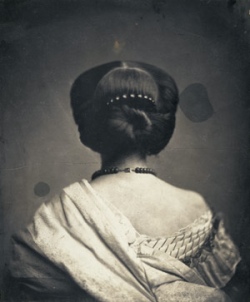Earlier this month I was wandering through an exhibit of work collected by Philippe de Montebello for the Metropolitan Museum. I found myself in front of a photograph by Richard Avedon of Marilyn Monroe. The context of the photo was the idea of theatrical self-impersonation. As Avedon tells the story, there is no such person as Marilyn Monroe.
“Marilyn Monroe was someone Marilyn Monroe invented, like an author creates a character.” Recalling a session that took place at his studio on a May evening in 1957, he continued: “For hours she danced and sang and flirted and did this thing that’s—she did Marilyn Monroe. And then there was the inevitable drop. And when the night was over and the white wine was over and the dancing was over, she sat in the corner like a child, with everything gone. I saw her sitting quietly without expression on her face, and I walked towards her but I wouldn’t photograph her without her knowledge of it. And as I came with the camera, I saw that she was not saying no.”
In the networked social space created by our new modes of communication and interaction we enact a similar form of theatrical self-impersonation. Most of who we are is hidden from view, each identity is constructed and by definition, incomplete. Shakespeare’s words ring true today as we signal to each through roles constructed and manipulated at a distance.
All the world’s a stage,
And all the men and women merely players:
They have their exits and their entrances;
And one man in his time plays many parts
Monroe established an economics for her self-impersonation and her product was, and is, in high demand. We see a similar dynamic in the blogosphere where economic value is created through the theatrics of self-impersonation. Steve Gillmor has written an excellent post that gives us a backstage pass to the theatrical process Mike Arrington uses to write a Mike Arrington post. One might add, of course, there is no such person as “Mike Arrington.”
But we shouldn’t limit our exploration to the commercial sphere, there are other modes in which this idea of theatrical self impersonation can play out. One of the stories that Ray Ozzie has been telling lately to introduce himself to Microsoft and the world has to do with a online system called Plato. An experience Ozzie had 33 years ago on an online network captured the promise and depth of this new space of interaction.
By the mid-1970s, PLATO’s many features included email and an instant messaging feature dubbed “Talk-O-Matic.” Ozzie wrangled a job working on the project, and, while doing so, communicated online with a collaborator who worked remotely from off-campus. Ozzie was impressed by the eloquence and intelligence of his offsite workmate and the two quickly bonded. Ozzie’s only complaint was that when they sent instant messages to each other, his offsite colleague was a frustratingly slow typist.
After their joint project was completed, Ozzie met his remote partner in person for the first time during a party at the partner’s house in 1975. Only then did Ozzie discover that his colleague was a quadriplegic, bound to a wheelchair, whose slow typing was a result of having to interact with the keyboard using a stick held in his mouth.
The incident had a profound effect on Ozzie. He was struck by how the technology allowed them to connect so closely, despite physical constraints and without preconceived judgments. The two had met in a shared mental space that was uniquely enabled by networked technology.
While we sometimes think of this networked social space we’re exploring as new, in an era where innovation occurs at lightening speed, the roots of the basic interactions reach back to a time out of mind.
The visible artifacts of these theatrical creations become detached from their originators and float freely in a field of play– currency traded in our social dance. Paul Ricoeur talks about these artifacts as “oneself as other” (Soi-meme comme un autre). While some talk of a technology that will allow us to aggregate the disaggregated, scooping up all the disparate pieces of personal identity and weaving them into a whole, the element of time renders these attempts necessarily partial. Perhaps we’re due for an exploration into the polar opposite of the single whole identity. The poet Fernando Pessoa created the literary concept of the heteronym. A heteronym possesses distinct temperaments, philosophies, appearances and writing styles– Pessoa had more than 70. Would the words I write here be the same ones I’d exchange with you over coffee at a little cafe on the other side of town? I really couldn’t say…
The poet is a faker
Who’s so good at his act
He even fakes the pain
Of pain he feels in fact.


